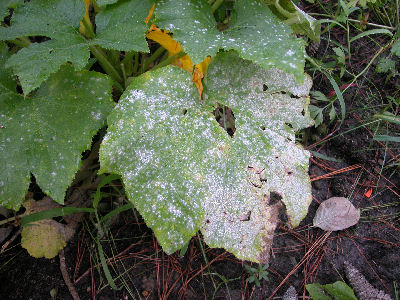Factors affecting crop spectral signatures
Plants have a particular way to reflect the electromagnetic radiation. This unique characteristic is known as the vegetation's spectral
signature. Reflectance of vegetation is very low in the blue and red regions of the electromagnetic spectrum, slightly higher in the green
region and high in the near infra-red. For more information on the vegetation spectral signature, see this
page.

Loss of chlorophyll in a leaf (chlorosis).
Source: Wikimedia Commons
The normal growth process of a plant can be disrupted when it goes through a stress period. When in stress, the plant is not functioning
properly because of one or more causes. When a plant is stressed, it usually expresses certain visible symptoms, but also some that are not
visible to the human eye. Stress symptoms may appear in all of the plants of the field or in some portions of the field, depending on the
cause.

Development of a fungus (Uncinula necator - commonly known as powdery mildew) on a melon plant.
Source: Wikimedia Commons
Stress is caused by a number of external factors. Can you think of any?
Answer
↓↑
- Water shortage (drought)
- Nutrient deficiency
- High concentration of damaging chemicals (toxicity)
- Extreme acidity or salinity in the soil
- Fungal, bacterial or viral infection
- Attack from insects or other organisms, above or below the ground
- Extreme temperatures (heat or frost)
- Root suffocation or lack of space for the roots to develop (e.g. saturation of clay soil with water or soil compaction)
- Lack of sunlight
- Structural damage by weather conditions (wind, snow, ice)
- Competition with other plants for light, nutrients, water or space
Example
↓↑
An insect attack will begin at one edge of the field and will gradually spread to the whole of the field over time. Soil compaction, on
the other hand, might only be a problem in one section of the field, hence only affecting the plants growing in that section.


